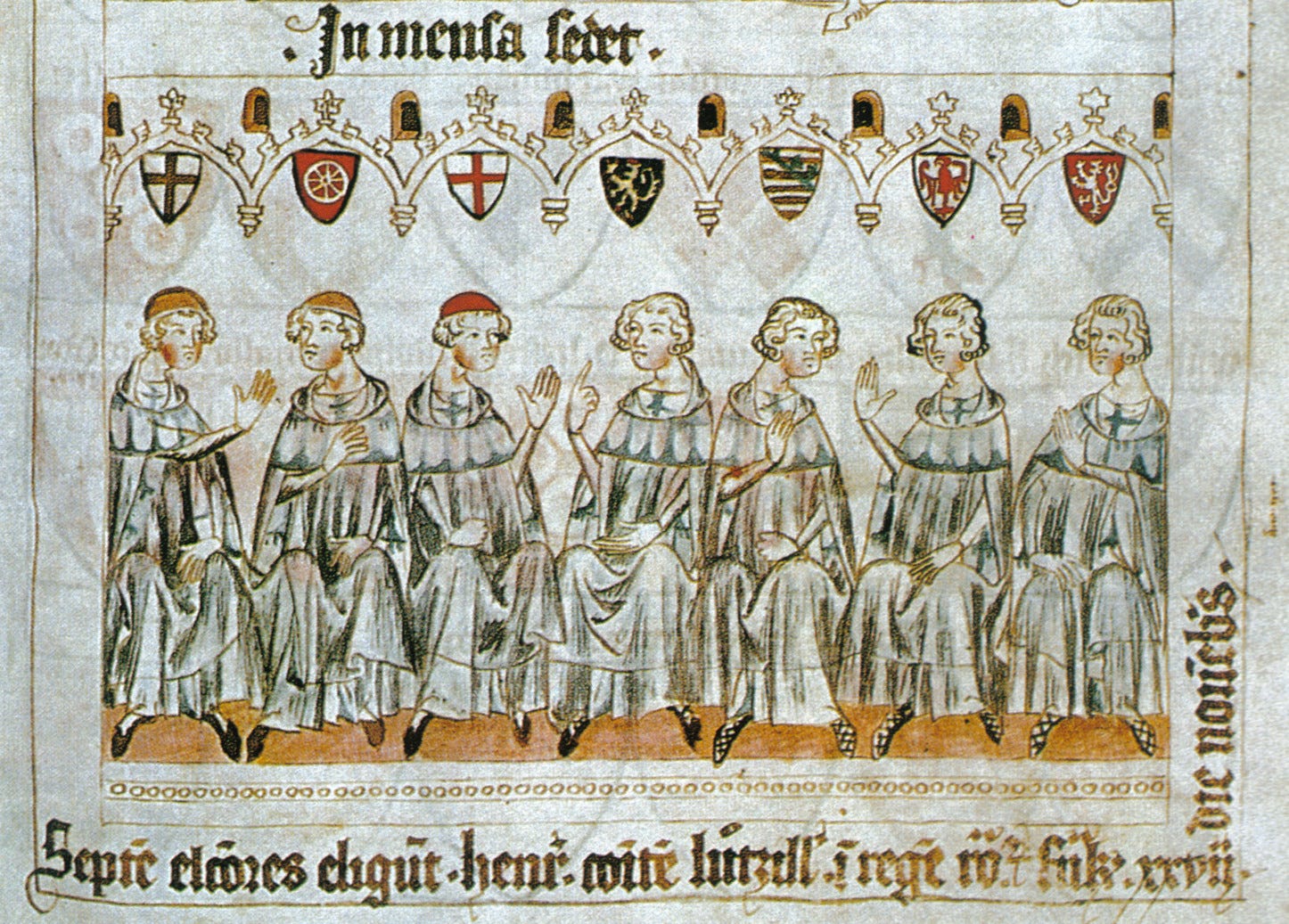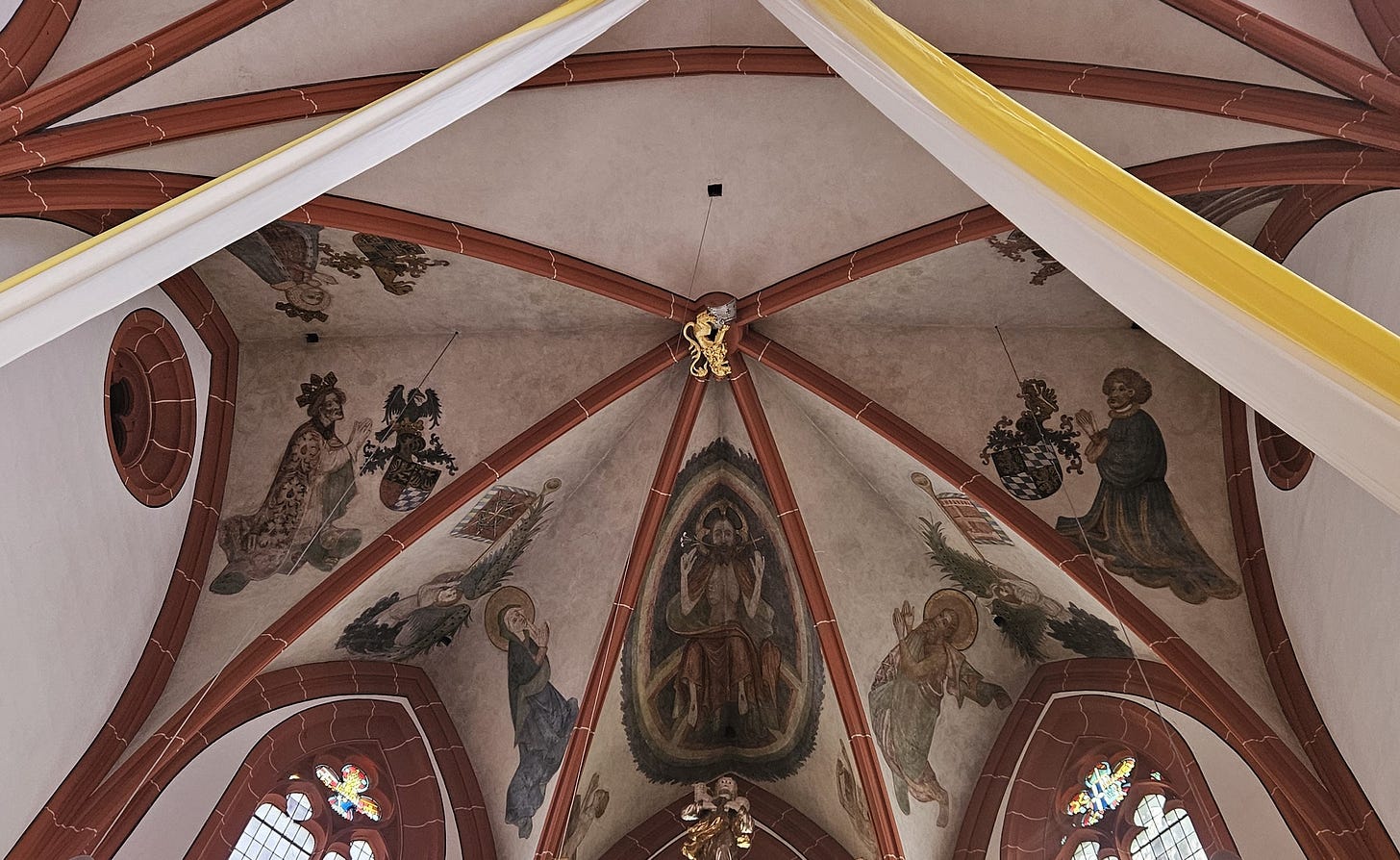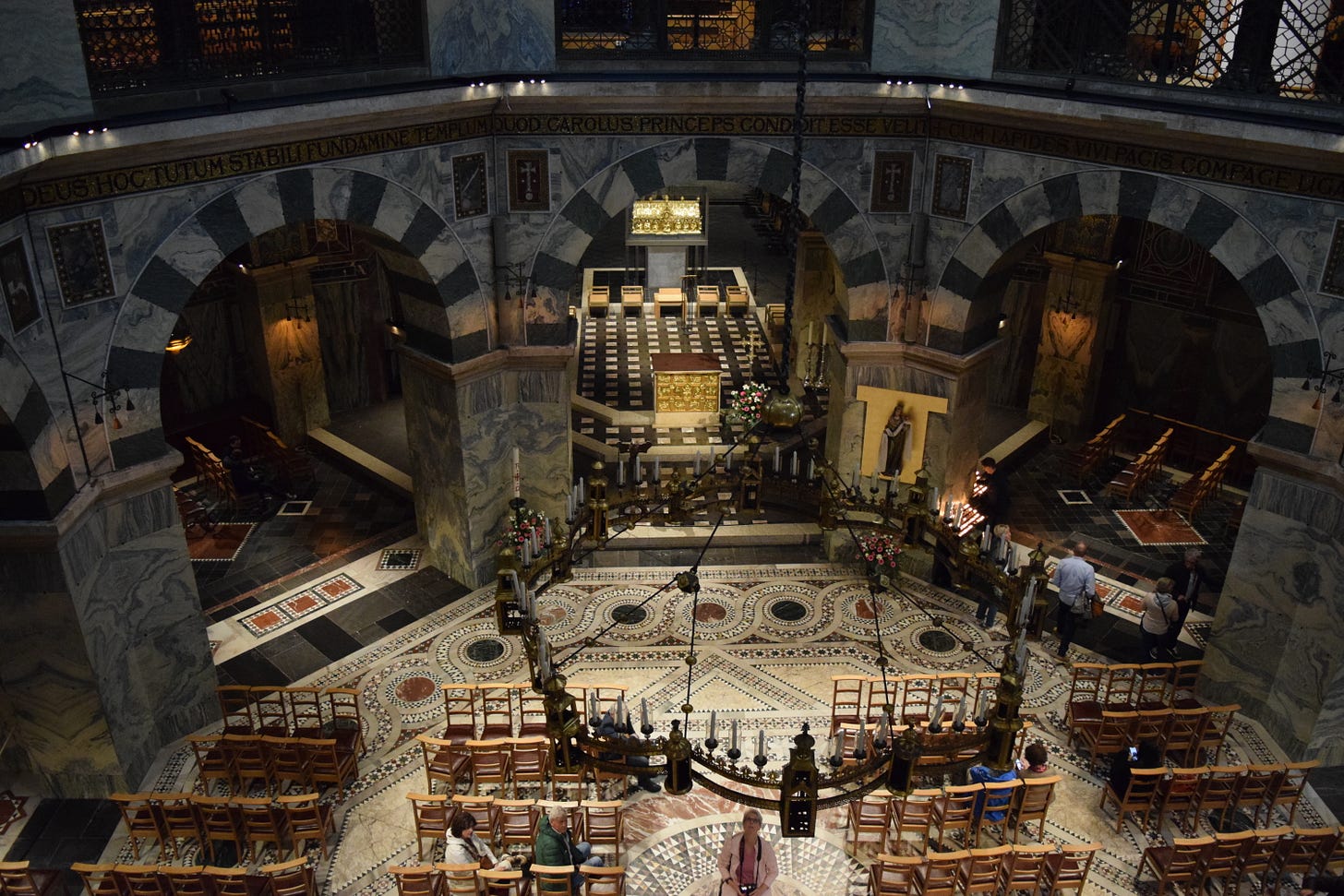What is a Prince Elector?
Electing kings was a key differentiation between the Holy Roman Empire and the other states of Europe. But who was responsible for the task and how were they chosen?
The topic of elections was touched upon in an article about the first election of an East Frankish King, Conrad I, and his successor, Henry I (the Fowler). It was also mentioned in part five of the Origins of the Holy Roman Empire series. Thus, those familiar with this substack will have encountered the topic at least a few times.
In a previous article we also discussed the definition of a prince and what it entailed. With this article we will dive a bit deeper into the nature of a prince elector as it was a status reserved for only a few princes and only within the Holy Roman Empire (HRE). How did one become an elector and how did they compare to one another?
The Golden Bull of 1356 AD
The prince electors, or princeps elector imperii, were specifically selected princes responsible for electing the Roman-German Kings who could then travel to Rome and be crowned emperor.
The standardization of the prince electors came about in the mid-14th century under Emperor Charles IV of the House of Luxemburg not only as a method in which to introduce some more legal formalizations into the HRE, but also to limit the say of dissenters—particularly in a time where politics, culture, and religion seemed to be unraveling (see last week’s article about the Avignon Papacy).
The term ‘bull’ is derived from the Latin bulla, meaning seal with which the monarchs would attach their royal insignia to particularly significant charters or proclamations. There were dozens of texts designated ‘Golden Bulls’ due to the attachment of a golden seal, so it is not specific to the bull of 1356 AD. This bull’s significance was the legal identification of seven princes to serve as permanent electors of the Roman-German Kings.
Given that it was the HRE, and that both church and state were inseparable, three of the princes were archbishops and four were from various secular positions. One may ask as to why the secular faction received the majority, to which there is an understandable, yet somewhat complicated explanation that we will expand upon here.

The Ecclesiastical Faction
The three archbishops were of Mainz, Cologne, and Trier. Both the Archbishops of Mainz and Cologne resided on the Rhine River, whereas the Archbishop of Trier was on the Moselle River. All three were located in the western portion of the HRE in cities that had once been illustrious Roman towns.
Mainz, known during the Roman period as Mongontiacum and in the Middle Ages as Magonza, was the most important of the three and also presided over the largest episcopal see within the HRE. In fact, the Archbishops of Mainz were long considered the most powerful prelates other than the pope during the High Middle Ages (1000 – 1300 AD). They also held the traditional title as imperial chancellor.
Cologne, known during the Roman period as Colonia Claudia Ara Agrippinensium and in the Middle Ages simply as Colonia, was the second most important (though some may argue this point) and second most populous city in the HRE. Cologne’s cathedral is home to the tombs of the Three Magi who visited the Nativity of Christ as well as a university whose preceding institution trained St. Thomas Aquinas. The Archbishops of Cologne enjoyed not only a multitude of ancient churches but were also the traditional chancellors of the Kingdom of Italy.
Trier, known during the Roman period as Augusta Treverorum and in the Middle Ages simply as Trier, controlled an episcopal sea that stretched all along the Moselle River and the region of Lorraine. The Archbishops of Trier were the most architecturally progressive minded prelates of the High Middle Ages and also guarded the Tunic of Christ in the Cathedral Reliquaries. Trier is home to one of the oldest Christian communities in the world, said to have been formed by Claudia, the wife of Pontius Pilate, after he was exiled to Augusta Treverorum for his abject failure in containing rebellion in the Kingdom of Judea. The archbishops also served the traditional role as chancellors of the Roman-German Kingdom.
Although the oldest known synagogue north of the Alps is in the city of Worms, all three cities were also home to large Jewish communities that were formed almost immediately upon the forced diaspora of the Jewish people following the destruction of Jerusalem in 70 AD by the Romans. It goes without saying too much more into the matter that Mainz, Cologne, and Trier were three of the most storied cities of the Middle Ages with a considerable sphere of influence.

The Secular Faction
The four secular princes were from Heidelberg, Saxony, Brandenburg, and Bohemia. Upon first glance it is clear that they were more scattered throughout the HRE than the archbishops with the noticeable absence of any Italians. Considering that the Holy Roman Emperors had to first be elected as the Roman-German Kings, the prince electors were only necessary within the northern kingdom.
The Counts Palatine of the Rhine (Pfalzgraf bei Rhein) were located in the city of Heidelberg, though there were a number of other Counts Palatine throughout the HRE. The German term Pfalzgraf originally referred to anyone representing the king as his official surrogate, though they became ever more associated with the region of the German Palatinate as time progresses.
The Counts Palatine of the Rhine were actually located on the Neckar River that flows into the Rhine at Mannheim—between the heavily influential cities of Mainz and Speyer. Furthermore, the Neckar controls the waterways into the Duchy of Swabia, which also controlled the Rhine. This critical juncture of the two major southern waterways is why the Counts Palatine of the Rhine were named electors and the official stewards of the HRE.
The dominant dynasty was the Bavarian House of Wittelsbach with its various cadet lines. The branch located in the Palatinate was based not only in Heidelberg, but in Simmern and Neustadt an der Weinstraße. The other main branch of the House of Wittelsbach remained as Dukes of Bavaria.

The Dukes of Saxony (Herzog von Sachsen) represented one of the oldest duchies in the HRE going back to Late Antiquity and the Early Middle Ages. Their seat toggled between the cities of Meissen, Torgau, Wittenberg, and later on, Dresden. Although the Margraviate of Meissen had been independent throughout the majority of the Middle Ages, it merged with the Electorate of Saxony under the House of Wettin int he mid-15th century.
Considering that the first Holy Roman Emperor was a Saxon duke, the Duchy of Saxony was held in high regard, often to the chagrin of the Dukes of Bavaria, Lorraine, and Swabia. The dukes were named electors as well as imperial marshals—a position they actually executed until the 18th century.
The Margraves of Brandenburg (Markgraf von Brandenburg) were located in the northeastern corner of the HRE along the border of the Realm of the Teutonic Knights and the Kingdom of Poland. Considering the intensely difficult position of ruling a march in an inhospitable region, they were named electors and imperial chamberlains.
Their traditional seat was in Berlin, which during the Middle Ages was simply a small town along the River Spree amidst the marshlands of Brandenburg. The main dynasty of the Middle Ages was the Saxon House of Ascania, but the House of Hohenzollern later ruled the margraviate until it was raised to the Kingdom of Prussia in 1701 AD.
The Kings of Bohemia (König von Böhmen) was the largest of the secular electorates and also ruled over a march, of sorts, as they were bordered by foreign territories such as the Kingdoms of Poland and Hungary. Their seat was in the city of Prague, which emerged as a major city in the HRE, in contrast to the other three seats of the secular electors.
The main dynasty was the House of Přemysliden that ruled for over 400 years, and later the House of Luxemburg. Besides being elevated to a prince elector, the Bohemian Kings were the imperial cupbearers as well.
In contrast to the ecclesiastical electors who all possessed the same title—though there were significant differences in the episcopal sees they administered—the secular princes all had different titles. The essential point here is that the lower the status title, the higher the electoral obligation. Thus, the Count Palatine of the Rhine was the lowest status title, but the most important secular elector as steward. In like manner, the King of Bohemia had the highest status title, but received the least significant electoral role.
Where did the Elections Take Place?
The death of a monarch necessitated a replacement. The period of Interregnum—or time in which no king ruled—would then be led by the imperial steward (the Count Palatine of the Rhine) who would call upon the other electors to assist in proclaiming the successor. The meetings would take place at what was known as a Reichstag or imperial diet where the premier princes of the HRE would converge.
These meetings followed the tradition of meetings beginning with the early medieval Frankish March Field gatherings in which the Merovingian Kings would meet with their military and political leaders to discuss legal matters and campaigns—similar to the Germanic Thing that the Vikings practiced well into the High Middle Ages.

These elections could happen in any number of locations, but typically occurred in imperial palaces such as Frankfurt am Main, Goslar, Aachen, etc. Although the steward would initiate the election, the archbishops presided over the coronation ceremonies.
The traditional throne for the coronation of the Roman-German King following his election was in Aachen, both in honor of Otto I, who was crowned king in 936 AD, and Charlemagne, who constructed the palace. In order to substantiate their claim to the throne, the candidates for the Roman-German King would demonstrate both their connection to the former emperors, though the deciding factors lay elsewhere.
Who Could be a Candidate for King?
This is the area where a clear continuation of the Carolingian Empire persisted throughout the HRE that succeeded it. In a previous series on the HRE, we explored the main dukes of East Francia: The Dukes of Bavaria, Lorraine, Saxony, Thuringia, and to a lesser degree, the Duke of Swabia.
These five dukes essentially ruled the entirety of East Francia, which later became the Roman-German Kingdom, thus putting them in the perfect position to be recognized as candidates for kingship. However, there were key exceptions that emerged at the turn of the 14th century, namely, the rulers of the Houses of Habsburg and Luxemburg. Although both were married into the dynasties of the five duchies, their houses began as counts.
They were the continuation of East Frankish counts who presided over marches or other borderlands. The Counts of Luxemburg were drawn from the region of modern-day Luxemburg and southern Belgium such as the region of the Ardennes and around the city of Namur, rising to power in the early 14th century. The Habsburg Counts were from modern-day eastern Austria and rose to power in the late 13th century. A more detailed discussion of the Counts of Habsburg and Luxemburg will be saved for another day, as their intertwined stories are fascinating, but are out of scope for this article.
It suffices to say that by the turn of the 14th century, the main criterion for kingship had shifted from identifying one’s genealogy to Otto the Great, to presenting oneself as a superior political and military leader—much in the way Charles Martell and Pippin the Short had accomplished in the 8th century. This largely had to do with the Great Interregnum from 1245 to 1273 AD in which no single king rule. Instead a series of kings and anti-kings were elected by the princes and installed by the archbishops until all agreed upon Rudolf of Habsburg in 1273 AD.
Prior to the Habsburg takeover of the Roman-German Kingdom, and thus the HRE as well, the kings typically came from the five ancient duchies that had generally aligned into two parties: the western duke composed of the Duchies of Lorraine, and Swabia; and the eastern dukes composed of the other three. Among their ranks were the nearly innumerable counts within their respective spheres of influence who acted as a tether to the lower status nobles.
Did the Electorship Expand?
The status of the seven Prince Electors remained stable throughout the tumult of the Avignon Papacy and the Protestant Reformation only to change during the Thirty Years War (1618 - 1648 AD). At the beginning of the war, Frederick V of the Bavarian House of Wittelsbach, line Pfalz-Simmern, ruled as both King of Bohemia and Count Palatine of the Rhine—two Electorships. His wife was Elizabeth Stuart, daughter of the English King James I.
Frederick V aligned himself with the Protestant forces of Bohemia against the Holy Roman Emperor, Ferdinand II. The dissidents in Bohemia then appointed Frederick as Ferdinand’s replacement, who had actually been the King of Bohemia. Frederick V’s usurpation of the Bohemian throne from the sitting emperor immediately drew the ire of the princes—both Catholic and Lutheran—resulting in his dismissal upon his defeat at the Battle of White Mountain in November 1620 AD. His rule in Bohemia lasted only a winter, thereby bestowing the nicknames Winter King for Frederick, and Winter Queen for Elizabeth.
After Bohemia was removed from him, Frederick still claimed the Electorate of the Rhine, but it was taken as well in 1623 AD and given to his cousin, the Duke of Bavaria, Maximilian I. At the end of the Thirty Years War following the Treaty of Westphalia in 1648 AD, Frederick V’s son, Charles Louis, was awarded the Electorate of the Rhine, but as essentially a minor partner of the Elector in Munich, Bavaria. Charles’ position as the eighth elector was a honor that provided his children with substantial fame, but with regard to actual elections, it was hardly of any significance.
The electors expanded once more to nine electors later on with the addition of Hannover in the late 17th century, but by that time the Habsburg stranglehold on the HRE had become a forgone conclusion no longer necessitating actual elections. Nevertheless, the title retained an immense status as many electors became kings themselves. For example, the Elector of Brandenburg became the first King of Prussia, the Elector of Saxony became the first King of Saxony, and an Elector of Hannover became King George I of England.
For more reading on this topic, look into these sources:
Kaufhold, Martin. Interregnum. 2nd ed. Geschichte Kompakt: Mittelalter. Darmstadt: Wissenschaftliche Buchgesellschaft, 2007.
Kern, Fritz. “Die Reichsgewalt des deutschen Königs nach dem Interregnum: Zeitgenössische Theorien.” Historische Zeitschrift 106, no. 1 (December 1, 1911): 39–95. https://doi.org/10.1524/hzhz.1911.106.jg.39.
Lubich, Gerhard. Auf dem Weg zur “Güldenen Freiheit”: Herrschaft und Raum in der Francia orientalis von der Karolinger- zur Stauferzeit. Historische Studien 449. Husum: Matthiesen Verlag, 1996.
Pöhlmann, Carl. “Die fränkischen Gaue vom 8. bis 12. Jahrhundert.” In Pfälzischer Geschichtsatlas: Im Auftrag der Pfälzischen Gesellschaft zur Förderung der Wissenschaften und des Vereins zur Herausgabe eines historischen Atlasses, edited by Wilhelm Winkler, 6. Neustadt an der Hardt: Verlag der Pfälzischen Geselleschaft zur Förderung der Wissenschaften, 1935.
Spiess, Karl-Heinz, Armin Reese, and Uwe Uffelmann. Das Lehnswesen in Deutschland im hohen und späten Mittelalter. 1st ed. Historische Seminar 13. Idstein: Schulz-Kirchner Verlag GmbH, 2002.




